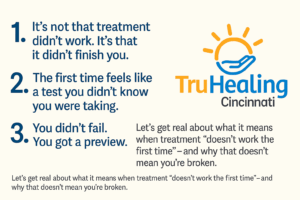You did the hard thing. You went. You stayed. And still, the pain came back.
Maybe it looked like using again. Maybe it just felt like nothing changed. Either way, if you’re reading this, chances are you’re asking the question that keeps a lot of people quiet:
Did treatment actually do anything? Or was it a waste of time?
Let’s get real about what it means when treatment “doesn’t work the first time”—and why that doesn’t mean you’re broken. If you’re considering another shot at a residential treatment program in Cincinnati, this one’s for you.
It’s Not That Treatment Didn’t Work. It’s That It Didn’t Finish You.
Residential treatment isn’t magic. It’s work. Real, sometimes brutal work. You go in with 15 years of pain and 30 days to untangle it.
Of course you’re going to walk out with loose threads. That’s not failure. That’s reality.
Treatment gives you a shot at stability—at a little distance from chaos. What happens after that? That’s where most of the battle lives.
The First Time Feels Like a Test You Didn’t Know You Were Taking
People think walking into treatment is the test. But the real test comes after:
Who are you when no one’s watching?
What do you do with cravings at 2am when your sponsor’s asleep?
I’ve seen people walk out with their heads high and slip three days later. I’ve also seen folks relapse the night they get home and still come back stronger.
The point? It’s not a pass/fail. It’s a process. Sometimes a messy, frustrating one.
You Didn’t Fail. You Got a Preview.
Most people don’t quit their substance use on the first try. Why would recovery be any different?
That first round of treatment is like turning the lights on in a cluttered room. You can finally see the mess. But that doesn’t mean you’re ready to clean it all up at once.
It’s overwhelming. Some people bolt. Others freeze. Some of us walk out with a half-scrubbed soul and think we’re cured—until life proves otherwise.
That’s not proof that treatment didn’t work. It’s proof you saw something true… and now you get to go back and finish it with clearer eyes.
What Does Make Treatment Work?
Here’s what I’ve seen make the difference:
- A program that treats you like a person, not a project
- Connection to staff who get it—because they’ve lived it
- Space to name what really hurts, without being rushed to fix it
- Support that continues after discharge, not just during your stay
That’s why programs like TruHealing Cincinnati’s residential treatment program exist. They’re built for people who’ve already tried. People who know the drill but still want more than just surviving.
Let’s Talk About What No One Talks About: The Shame Loop
Here’s the cruel part. When treatment “doesn’t work,” most of us don’t blame the program.
We blame ourselves.
“You had the shot. You blew it.”
That voice gets loud.
It says you’re wasting everyone’s time. That you’re hopeless. That no one’s going to believe in you the second time.
That voice is a liar.
Getting help again doesn’t mean you’re weak. It means you’re honest. It means you’re willing to keep showing up in your own life—even when it’s hard to believe it’ll be worth it.
Treatment Didn’t Work Because It Wasn’t the Right One Yet
Sometimes the first program isn’t a fit. Maybe it was too rigid. Too loose. Too group-heavy. Too clinical. Not enough peer connection.
Every program has a different approach. If you landed in one that didn’t speak your language, that’s not a sign you can’t recover. It’s a sign you need something that actually gets you.
Places like Lexington and Springfield, Ohio are seeing more treatment seekers ask hard questions—and that’s a good thing. You deserve to know what kind of care you’re stepping into.
There’s a Version of You That Still Believes You’re Worth Saving
You wouldn’t be reading this if you didn’t believe—at least a little—that healing is still possible.
That tiny thread of curiosity? That’s enough. That’s hope in its quietest form.
Recovery doesn’t demand perfect faith. Just a willingness to try again.
What Comes Next (If You Let It)
You don’t have to fake hope. You just have to move toward it.
Whether you’re in Cincinnati or looking at programs in nearby areas like Louisville, Kentucky, the door is open.
Sometimes “trying again” feels like the scariest thing in the world. But sometimes it’s the bravest.
Call (888) 643-9118 or visit TruHealing Cincinnati’s residential treatment program to learn more about how we work with people who’ve been through treatment before—and want it to actually work this time.
FAQs: What People Like You Ask—But Don’t Always Say Out Loud
Is it normal to relapse after treatment?
Yes. More common than people admit. It doesn’t mean you’re broken or weak—it means you’re human. What matters most is what you do next.
How do I know if a residential treatment program is right for me now?
Ask yourself this: Do I need time away from the chaos to reset? Do I need full focus, full support, and full immersion to face what’s underneath my using? If the answer is even “maybe,” it’s worth a call.
I already know what they’re going to say in group. Why go again?
Because it’s not about what they say. It’s about what you hear this time. Healing isn’t new information—it’s different interpretation. You’ll hear something differently because you are different now.
How is TruHealing Cincinnati different from other places?
Their residential program is built around lived experience. They work with people who’ve been through treatment before and need care that doesn’t condescend or sugarcoat. They know this might not be your first round—but they’re ready to help make it your last.


